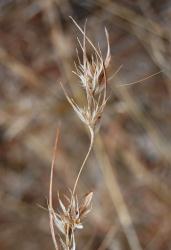- Taxon
- Gallery
- = Anthistiria imberbis Retz. (1783)
- = Anthistiria australis R.Br. (1810)
- ≡ Themeda forskalii (Kunth) Hack. ex Duthie (1889)
- = Anthistiria forskalii Kunth
Stiff, reddish glaucous perennial tufts often forming large patches; branching intravaginal. Leaf-sheath light greenish brown to reddish tinged, coriaceous, keeled, lower sheaths villous, hairs fine tubercle-based, upper sheaths more sparsely hairy to glabrous. Ligule 0.7–1 mm, membranous, truncate, erose or shortly ciliate, finally shredding into fine cilia. Leaf-blade 15–35 cm ×c. 2 mm, folded to flat with revolute margins, strongly keeled, of similar texture to sheath, scabrid, often a few tubercle-based hairs near margins above ligule; margins and midrib pubescent-scabrid near long, fine, acicular tip. Culm 25–90 cm, internodes glabrous. Panicle 15–35 cm, spikelets in 2–4 clusters at tips of slender branches, each cluster slightly overtopped by leaf-like spathe and consisting of 2–4 spikelet-fascicles; each fascicle subtended by a spathe-like bract > spikelets but < awns; rachis 2–3.5 mm, callus-like and covered with dense fulvous hairs; segments falling with sessile and pedicelled spikelets. Involucral spikelets ♂ or Ø: 8.5–15 mm, dorsally compressed, persistent; glumes ± equal, acuminate; lower firmly membranous, closely 11-nerved, inflexed and keeled near narrow hyaline margins, upper subhyaline, 3-nerved, 2-keeled with ciliate margins; lemma of lower floret shorter, 1-nerved; lemma of upper floret minute, or 0; palea 0; anthers, when present, 2.5–5 mm. Pedicelled spikelets: 9.5–13 mm, similar to involucral spikelets but narrower; pedicels glabrous, c. 2 mm. Sessile spikelets ☿: 3.5–8 mm, narrow-elliptic; lower glume obscurely 7–9-nerved, fulvous, with stiff reddish hairs just below apex, upper shortly pubescent near apex; lemmas < glumes, glabrous, spike-like in upper floret, awn 3.5–5.5 cm, geniculate, column brown, pubescent, bristle scabrid; anthers c. 2–2.5 mm; caryopsis 4.5 mm.
[From: Edgar and Connor (2000) Flora of New Zealand. Volume 5 (second printing).]




